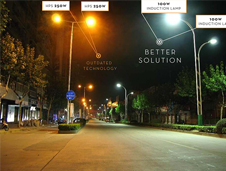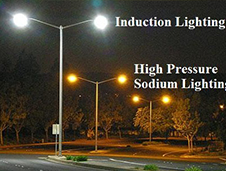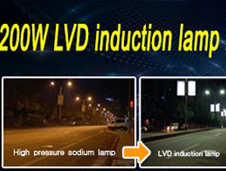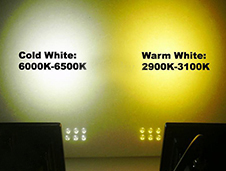
COMPARISION
Induction Vs LED
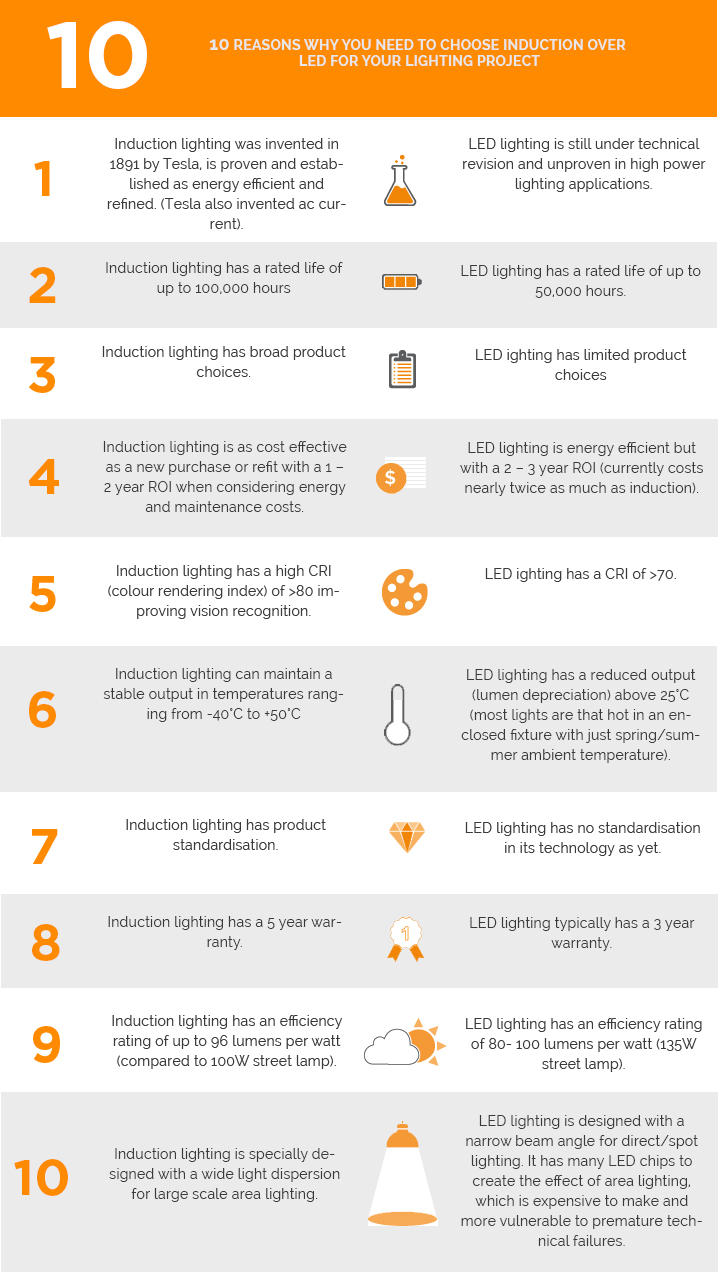
Although induction lamp technology has improved significantly in recent years, it is often overlooked and under utilised in lighting applications, being overshadowed by the ever growing popularity of LED lighting.
LED technology is at the forefront of energy saving lighting solutions and is promoted as the best alternative to conventional lighting due to its longevity and energy saving benefits. Induction lamps have a life-span of 80,000 to 100,000 hours (depending on type and model). The major difference between the technologies is in conversion efficiency (energy utilisation) and costs. This is particularly significant where a large area of illumination is needed, for example, outdoor, warehouse, or gymnasium settings.
Most commercial LED lighting fixtures have conversion efficiencies in the 80 - 100 Lumens/Watt (L/W) range. LED elements with a conversion efficiency of over 90 L/W are still quite expensive. Induction lamps have a conversion efficiency ranging from 65 L/W in low wattage (8 ~ 20 W internal inductor types) to 90 L/W in the high wattage (250 ~ 400 W external inductor models) range. Since the most powerful single element LEDS available at this time are in the 20 ~ 25W range, to make a 200W fixture, an array of LED elements must be used. This adds to the expense of the fixture since the cost of these more powerful LEDS is presently quite high and they require custom heat-sinks for thermal management.
Since induction lamps use well established and mature glass moulding and coating technology with electronic ballasts (similar to fluorescent lamp technology), manufacturing costs are lower and yields higher than LED at this time. Typically an induction lamp fixture will cost less than a similar output LED based fixture.
LED however, does have the same theoretical life-span of 100,000+ hours as induction light, provided the integrated chip does not fail before the diode. Many LED manufacturers neglect to fit a decent high temperature IC or integrate some kind of heat dissipation device and their LED fail after only 20,000 - 30,000 hours. Induction lighting on the other hand, offers the same stability and life-span as LED but is available in much higher wattages and brightness so that it can replace incandescent and discharge lamps as the next revolutionary lighting source.
The Advantages of Magnetic Induction Lamps:
- Long life-span due to the lack of electrodes - between 80,000 and 100,000 hours depending on the lamp model.
- Very high energy conversion efficiency of between 72 and 90 Lumens/watt [higher wattage lamps are more energy efficient].
- High power factor due to the low loss in high frequency electronic ballasts which are 98% efficient.
- Minimal lumen depreciation (declining light output with age) compared to other lamp types as filament evaporation and depletion is absent.
- ”Instant-on” and hot re-strike, unlike most conventional lamps used in commercial/industrial lighting applications (i.e. Sodium and Metal Halides).
- Environmentally friendly as induction lamps use less energy, and generally use less mercury per hour of operation than conventional lighting due to their long life-span. The mercury is in a solid form and can be easily recovered if the lamp is broken, or for recycling at end-of-life.
- These benefits offer a considerable cost saving of around 50% in energy and maintenance costs for induction.
- Long operating life in hotter ambient temperatures due to not requiring efficient heat dissipation.
Contact us for more information or to arrange an on-site demonstration on power saving.
Induction vs High Pressure Sodium
- Induction Lighting has a bulb life rating of up to 100,000 hours. HPS is rated for 20,000 hours.
- Induction Lighting has slow lumen depreciation (light loss) and can maintain up to 90% of original lumens for 80,000 hours or more. HPS has fast lumen depreciation similar to metal halide. Bulb life is twice as long as metal halide. This is why it may be chosen as an alternative to metal halide in high reach areas. It is just not the best choice.
- Induction Lighting is nearly maintenance free for the rated life of the bulb/ballast and carries a 5 year warranty.HPS takes more maintenance and has no known warranty.
- Induction Lighting has a high colour rendering index (CRI) of 80+. This makes colours much more vivid. HPS has a low CRI of 20 - 22. This is why colours are so hard to see with this intense "yellow" light.
- Induction Lighting has a high S/P ratio of 2.0 +. This makes the lumens per watt more efficient. HPS has a low S/P ratio of .62. This low number reveals wasted “non viewable" lumens.
- . Induction Lighting has high visual acuity "viewable" lumens per watt of 191. HPS has only 67 lumens of "viewable" lumens per watt, revealing poor efficiency with the need for nearly 3 times more watts than the crisp white light of induction.
- Induction Lighting is instant-on and instant re-strike. HPS is delayed up to 10 minutes.
- Induction Lighting is better for the environment using only 5 - 6mg. of amalgam (dentist style mercury) per bulb which is in a solid form and therefore easy to recycle. HPS uses 10 - 50mg. of mercury and is difficult in its form to recycle. The 10 mgs. of mercury from only one 48 inch fluorescent bulb can make 6,000 gallons of water unfit to drink. It will take 5 of these HPS bulbs in the environment to compete with the life of one induction bulb and 10 times more mercury is exposed.
- Induction Lighting operates at a much cooler 65C – 84C degrees. HPS operates at 233C to 398C degrees. This is much hotter and impactful to the environment. Induction lighting is clearly the best choice. Please research the product listing for your lighting needs. SMGBL is a producer for induction products and can retrofit most existing fixtures or install new fixtures. Call or email us with any questions or to discuss your needs.
Contact us for more information or to arrange an on-site demonstration on power saving.
Induction Vs Metal Halide
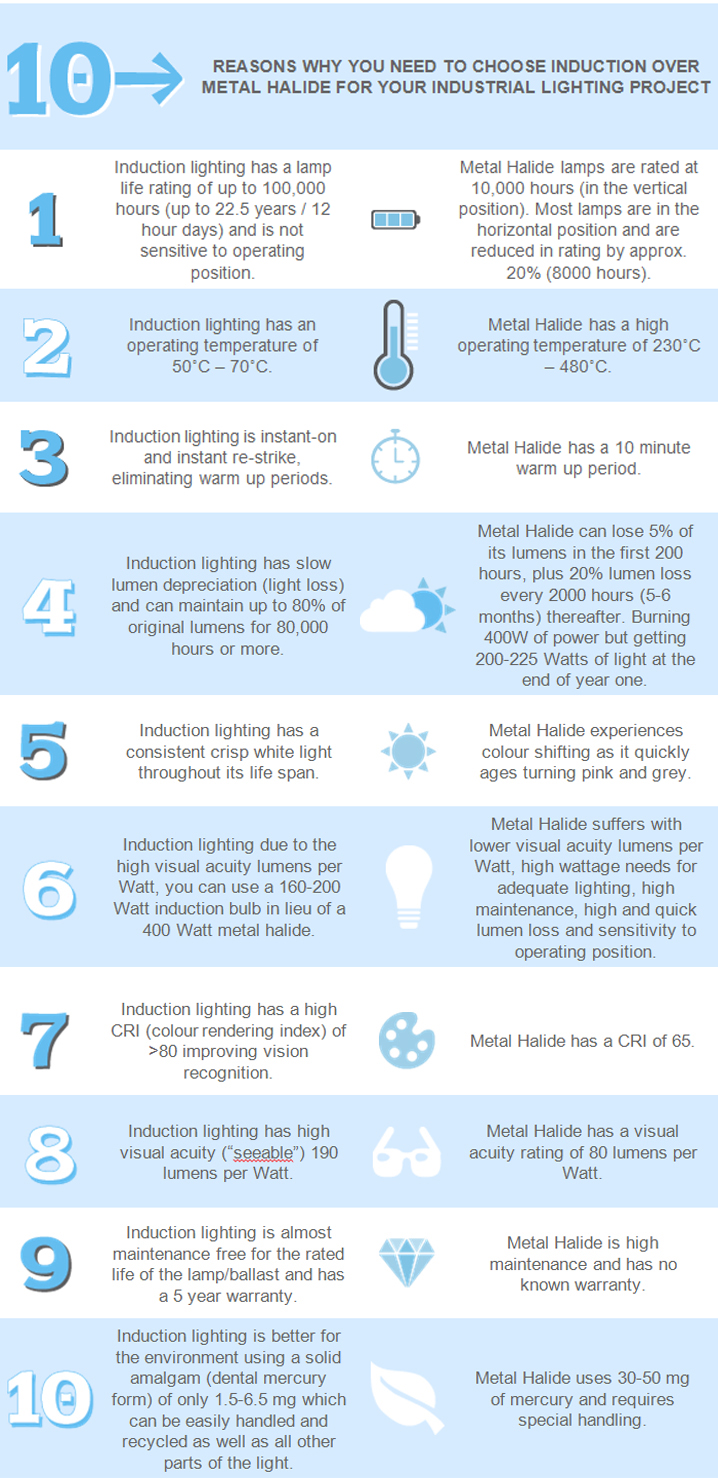
Contact us for more information or to arrange an on-site demonstration on power saving.
Others
Induction Lamp vs Metak Halide Lamp vs Sodium Lamp:
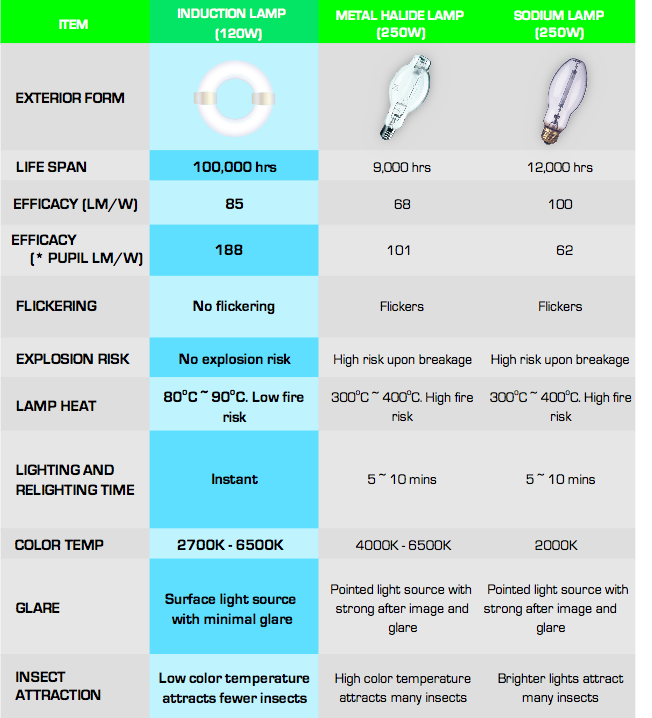
Induction Light vs LED Light:
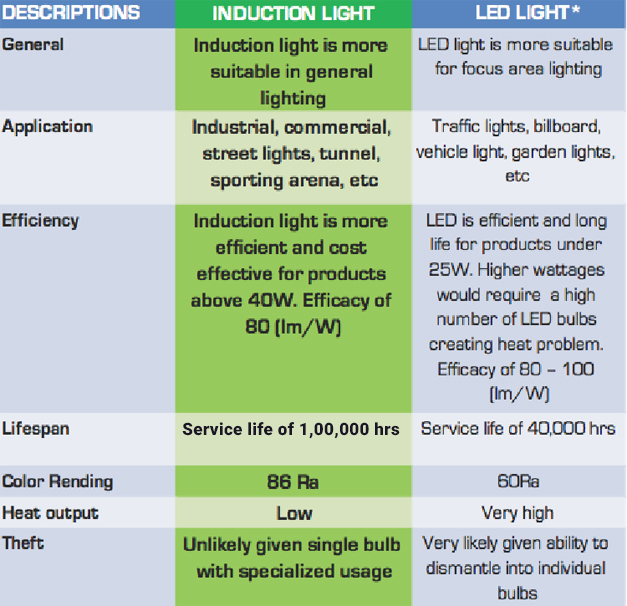
Gallery
Contact us for more information or to arrange an on-site demonstration on power saving.

